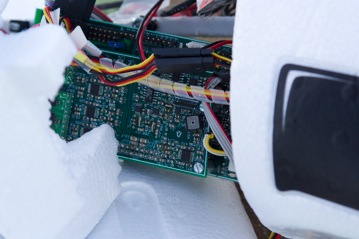Fully Flight Tested
Posted by: Mariano I. Lizarraga
So after endless hours in the lab I am happy to report success in all fronts of the autopilot and making the GIT repository publicly available. The following plots show the XY plot of the Airplane as well as the autopilot’s inner loop response to commands from flight tests.
Read More...
So after endless hours in the lab I am happy to report success in all fronts of the autopilot and making the GIT repository publicly available. The following plots show the XY plot of the Airplane as well as the autopilot’s inner loop response to commands from flight tests.
Read More...
Inner Loop / Navigation in Hardware-in-the-Loop
Posted by: Mariano I. Lizarraga
Waypoint tracking is one of the most sought-out features in an autopilot. Essentially it allows the end-user to program (generally via a map or an aerial picture) a path (composed of waypoints) that the UAV is commanded to track. When we started working on SLUGS it was clear that this would be the first high-level feature we would add. And today I am happy to report that it is fully working in software simulation and hardware-in-the-loop (HIL).
Read More...
Waypoint tracking is one of the most sought-out features in an autopilot. Essentially it allows the end-user to program (generally via a map or an aerial picture) a path (composed of waypoints) that the UAV is commanded to track. When we started working on SLUGS it was clear that this would be the first high-level feature we would add. And today I am happy to report that it is fully working in software simulation and hardware-in-the-loop (HIL).
Read More...
Temperature compensation. It does matter.
Posted by: Mariano I. Lizarraga
Temperature compensation is one of those capabilities that when included in a sensor board can go a long way to reduce the temperature dependence on the computed measurements. The SLUGS AP includes a low-power active thermistor from Microchip (MCP9701A). This thermistor is really cheap and requires very little board real state. In our case, the thermistor has proven essential to conduct temperature compensation on our sensor measurements.
Read More...
Temperature compensation is one of those capabilities that when included in a sensor board can go a long way to reduce the temperature dependence on the computed measurements. The SLUGS AP includes a low-power active thermistor from Microchip (MCP9701A). This thermistor is really cheap and requires very little board real state. In our case, the thermistor has proven essential to conduct temperature compensation on our sensor measurements.
Read More...
Crash
Posted by: Gabriel Elkaim
 It was supposed to be a routine test.
It was supposed to be a routine test.
Towards the end of the year, December 30th, we were going to fly to collect some data to verify our attitude estimation filters. It was a bright clear day, cold, with almost no wind to speak of.
As per our usual routine, we set up down at the field, and flew the small R/C plane first to make sure that flying conditions were appropriately benign.
We did our first flight around the patch with the UAV, and it seemed to be doing fine. We were suffering telemetry dropouts, and we were a bit paranoid because we had crashed from an R/C outage on the prior flight. We had replace the RX with a better one that would not suffer from signal fading.
After a 5-6 minute flight, we landed and swapped out the battery. We tried to download the flight data off of the SD card, but could not get it to read. We figured we would get some more data and then call it a day.
As an important note, the autopilot at this point is passively listening in on the R/C and recording the sensors. It is not driving anything, and is just there as a passenger on the aircraft.
About two minutes into the flight, the pilot (Greg) called out that he had lost control of the A/C and it went into a steep dive ending with a loud crunch into the parking lot.
Read More...

Towards the end of the year, December 30th, we were going to fly to collect some data to verify our attitude estimation filters. It was a bright clear day, cold, with almost no wind to speak of.
As per our usual routine, we set up down at the field, and flew the small R/C plane first to make sure that flying conditions were appropriately benign.
We did our first flight around the patch with the UAV, and it seemed to be doing fine. We were suffering telemetry dropouts, and we were a bit paranoid because we had crashed from an R/C outage on the prior flight. We had replace the RX with a better one that would not suffer from signal fading.
After a 5-6 minute flight, we landed and swapped out the battery. We tried to download the flight data off of the SD card, but could not get it to read. We figured we would get some more data and then call it a day.
As an important note, the autopilot at this point is passively listening in on the R/C and recording the sensors. It is not driving anything, and is just there as a passenger on the aircraft.
About two minutes into the flight, the pilot (Greg) called out that he had lost control of the A/C and it went into a steep dive ending with a loud crunch into the parking lot.
Read More...
Why Another Autopilot?
Posted by: Mariano I. Lizarraga
One of the first questions I got from both of my advisors when we started discussing about developing SLUGS was “Why another autopilot?” Certainly there are many fine open source and commercial options, and it would seem like every week there is a new one. It was my believe then and still is now, that all of the available autopilots where geared towards users who, most of the time, wanted a turn-key solution. That is users that wanted an autopilot to fly their UAV to some waypoints and relay information back, some in real-time others by logging data onboard. But very few were actually geared towards facilitating research on control systems. If you wanted to modify say the Kalman filter in one of the open source options, you were in for some serious high level programming and debugging.
Read More...
One of the first questions I got from both of my advisors when we started discussing about developing SLUGS was “Why another autopilot?” Certainly there are many fine open source and commercial options, and it would seem like every week there is a new one. It was my believe then and still is now, that all of the available autopilots where geared towards users who, most of the time, wanted a turn-key solution. That is users that wanted an autopilot to fly their UAV to some waypoints and relay information back, some in real-time others by logging data onboard. But very few were actually geared towards facilitating research on control systems. If you wanted to modify say the Kalman filter in one of the open source options, you were in for some serious high level programming and debugging.
Read More...
